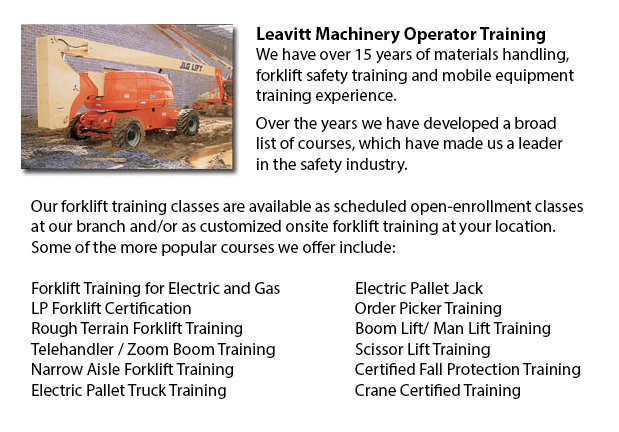
Aerial Boom Lift Training Red Deer - Aerial Boom Lift Training is required for anybody who supervises, operates or works in the vicinity of boom lifts. This particular type of aerial lift or aerial work platform is for lifting individuals, tools and materials in projects requiring a long reach. They are usually used to access other above ground job-sites and utility lines. There are various types of aerial booms lifts, such as cherry pickers, articulating boom lifts and extension boom lifts. There are two types of boom lift: "telescopic" and "knuckle".
Boom lift training is essential and usually involves the basic operations, equipment and safety matters. Employees are required when working with mobile machinery to understand the rules, dangers, and safe work practices. Training program materials offer an introduction to the terminology, applications, concepts and skills necessary for employees to obtain competence in boom lift operation. The material is aimed at workers, equipment operators and safety experts.
For your business needs, this training is adaptive, cost-effective and educational and will help your workplace become safer and more effective, allowing for higher levels of production. Less workplace incidents happen in workplaces with strict safety guidelines. All equipment operators need to be trained and assessed. They require understanding of existing safety measures. They should comprehend and follow guidelines set forth by their employer and local governing authorities.
It is the responsibility of the employer to make sure that workers who are required to use boom lifts are trained in their safe use. Each different kind of workplace machinery requires its own equipment operator certification. Certifications are offered for aerial work platforms, articulating booms, industrial forklift trucks, scissor lifts, and so forth. Fully trained workers work more effectively and efficiently compared to untrained personnel, who need more supervision. Proper instruction and training saves resources in the long run.
Training is the best prevention for the primary causes of workplace deaths: electrocutions, falls and tip overs or collapses. Aside from training, the best way to avoid workplace accidents is to maintain and operate aerial work platforms based on the instructions of the manufacturer. Allow for the combined weight of the materials, worker and tools when adhering to load limitations. Never override hydraulic, mechanical or electrical safety devices. Workers must be securely held inside the basket making use of a restraining belt or body harness with an attached lanyard. Do not move lift machine whilst employees are on the elevated platform. Workers should be careful not to position themselves between the basket rails and beams or joists in order to prevent being crushed. Energized overhead power lines must be at least 10 feet away from the lift equipment. It is suggested that employees always assume wires and power lines may be energized, even if they appear to be insulated or are down. Set the brakes and utilize wheel chocks if working on an incline.
-
Fall Protection Ticket Red Deer
Fall Protection Ticket Red Deer - The number one reason of death in the construction industry come from fall-related incidents. There is more possibility for fall accidents depending upon the kinds of work being done in your workplace. Therefore, kno... More -
Overhead Crane Certification Red Deer
Overhead Crane Certification Red Deer - The overhead crane certification course is a course that is designed to help trainees, even if they have language or literacy limitations. The course comprises a practical hands-on training session and a classr... More -
Wheel and Track Loader Training in Red Deer
Lift trucks are obtainable in a variety of various models which have various load capacities. Nearly all typical lift trucks utilized in warehouse settings have load capacities of 1-5 tons. Bigger scale models are utilized for heavier loads, like for... More -
Heavy Equipment Certification Red Deer
Heavy Equipment Certification Red Deer - Heavy duty vehicles are big pieces of machines which are usually known as heavy equipment. It is a broad term that literally includes whatever big utility vehicle in the area of agricultural and forestry imple... More -
Heavy Equipment Operator Classes Red Deer
Heavy Equipment Operator Classes Red Deer - A person who has the correct training to be able to use a particular kind or piece of machine is referred to as an equipment operator. There are different ways that an equipment operator can become trained... More -
Forklift Training Programs Red Deer
Forklift Training Programs Red Deer - Are you searching for a job as a driver of a forklift? Our regulatory-compliant mobile equipment operator training offers instruction in kinds of lift trucks, pre-shift check, fuel types and dealing with fuels, a... More -
Crane Safety Training Red Deer
Crane Safety Training Red Deer - Both crane driver and their supervisors must know all the potential problems related to the operation of an overhead crane. All over North America, there is legislation which provides rules for the safe inspection, ma... More -
Aerial Lift Training Red Deer
Aerial Lift Training Red Deer - An aerial work platform is a mechanized access platform. This device provides access to otherwise inaccessible places for people or equipment. Likewise called an elevating work platform or aerial device, the machinery... More

Forklift Training Red Deer
TOLL FREE: 1-888-254-6157
Red Deer, Alberta
forklifttrainingreddeer.com
Email Us
About Us


